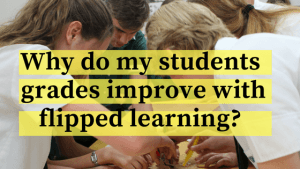Why do my students’ grades improve with flipped learning?
Author: Steve Griffiths
Go to Source
Just like all teachers, at the beginning of the year, I check out the available data on my new students regarding their grades last year. I then promptly forget this information due to the frenetic pace of the first few weeks of term. I then get to know my students in my in-class flipped mastery classroom and make my own evaluation of my students. I think that I am able to predict those students who will get As in my subject because they demonstrate grit, and agency and are progressing through the course well. So, I was surprised the other day when I went back to the data and found that a good number of students that I thought would get As actually got Cs last year.
 I naturally reflected on what was going on here. I think the explanation is that the students respond well to a flipped learning classroom and my students had not previously experienced it. So what is it about flipped learning that is most likely to benefit these students? I think there are a number of reasons why my students respond favourably to flipped learning.
I naturally reflected on what was going on here. I think the explanation is that the students respond well to a flipped learning classroom and my students had not previously experienced it. So what is it about flipped learning that is most likely to benefit these students? I think there are a number of reasons why my students respond favourably to flipped learning.
Active, student-centred learning:
In Alison King’s (1993) seminal work “from Sage on the Stage to Guide on the Side” she says that students are not empty vessels filled passively by an instructor lecturing content but instead, understanding is actively constructed (King, 1993). Flipped learning increases the amount of time students spend engaged in active learning because the teacher is not the “sage on the stage” but the “guide on the side”.
Prince (2004) defined active learning as “any instructional method that engages students in the learning process…….Active learning requires students to do meaningful learning activities and think about what they are doing”. Active learning has been found to increase student performance (Freeman, et.al., 2014). Flipped learning is a pedagogy that facilitates students to engage in active learning (Abeysekera and Dawson, 2015).
Flipped learning emphasizes student-centred, active learning in the group space through a variety of rich, meaningful learning experiences that explore concepts in greater depth and complexity and support the students’ construction of knowledge (Bergmann and Samms, 2012; Talbert, 2017).
Differentiation:
Flipped learning allows all students to work at their own pace. In the individual space, they can pause and rewind the video as often as they like, they can take a little longer to take better notes and they can go back and re-watch the videos later.
The role of the teacher in the flipped classroom also allows differentiated instruction and support for every student every day. By interacting with every student, in every class, the teacher can tailor their support to the individual student, if and when they need it. In a traditional classroom, it is often the best students that get the most attention from the teacher because they are asking and answering the questions. Whereas, in a flipped classroom, the students that struggle the most get the most help. “We think that this may be the single most important reason students thrive in the flipped model” (Bergmann & Sams, 2012, p.23).
Relationships:
Jo Boaler (2002) says that interactions between students and the teacher and between students are an essential part of a student’s learning and development. The interactions between students and the teacher in a flipped classroom are more frequent than the traditional classroom model (Bergmann and Samms, 2012). “Flipping allows us to build better relationships with our students” (Bergmann and Samms, 2012).
The reasons I think that my students respond well to the flipped classroom are because of the increased active, student-centred, learning, the differentiated instruction and the rich relationships. Perhaps there are other reasons as well. All I know is that many of my students show significant improvement in their grades in the flipped classroom.
Post script to this post is that the first assessment has now been graded and it has confirmed my suspicions that students are performing better this year in a flipped classroom.
Please join me @ FlipCon NZ or FlipCon Australia where I will be running a Cohort and presenting a break-out, I’d love you to come and say Hi – www.flipconaus.com
References:
Abeysekera, L., & Dawson, P. (2015). Motivation and cognitive load in the flipped classroom: Definition, rationale and a call for research. Higher Education Research & Development, 34(1), 1-14. 10.1080/07294360.2014.934336
Bergmann, J., & Sams, A. (2012). Flip your classroom: Reach every student in every class every day. International Society for Technology in Education.
Boaler, J. (2002). Learning from teaching: Exploring the relationship between reform curriculum and equity. Journal for Research in Mathematics Education, 33(4), 239-258.
Freeman, S., Eddy, S.L., McDonough, M., Smith, M.K., Okorafor, N., Jordt, H., and Wenderoth, M.P., (2014). Active learning increases student performance in science, engineering, and mathematics. Proceedings of the National Academy of Sciences (PNAS), 111 (23), 8410-8415.
King, A. (1993). From sage on the stage to guide on the side. College teaching, 41(1), 30-35.
Prince, M. (2004). Does active learning work? A review of the research. Journal of Engineering Education, 93(3), 223-231. 10.1002/j.2168-9830.2004.tb00809.x
Talbert, R. (2017). Flipped Learning: A Guide for Higher Education Faculty. Stylus Publishing, LLC.
The post Why do my students’ grades improve with flipped learning? appeared first on Education Technology Solutions.
